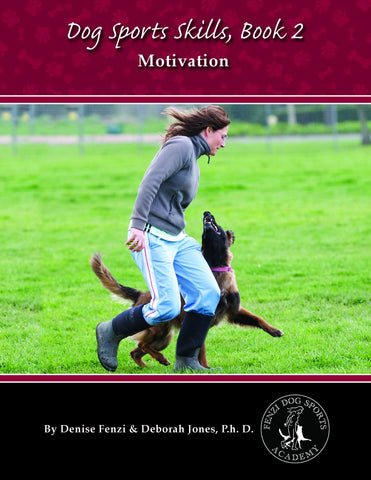Dog Sports Skills, Book 2: Motivation - including shipping

This is the second book in the award winning "Dog Sports Skills" series by Denise Fenzi and Deborah Jones; this time the topic is Motivation!
Winner of the 2014 Maxwell award for Book of the Year in the category "Behavior and Training"! Book one of this series (Building Engagement and Relationship) also won the award in 2013.
Authors: Denise Fenzi and Deborah Jones
Foreword by: Ken Ramirez
Subject Matter:
In this second book in the "Dog Sports Skills" series, Authors Denise Fenzi and Deb Jones take an in-depth look at the topic of motivation. They talk about what motivation is, and what it is not, along with an illuminating discussion of how a dog is unique in the animal world, and how educated trainers can use that to maximum advantage. They consider a range of options for motivating our dogs, and how a trainer can raise or lower the value of specific motivators to get the exact training effect that may be desired at a given time. Temperament is discussed as it relates to issues of motivation to help the reader understand the strong interplay between temperament, motivation and training decisions.
In addition to explaining how to use motivators in training, this book provides specific information on how to reduce their use so that you can eventually get into the competition ring!
Finally, they provide case studies - lots of them! The purpose of the case studies is both to cement what the reader has learned in the first chapters and also to help the reader understand how to analyze specific situations and make a plan to apply the concepts.
A student who reads both this book and the first book in the series will begin to develop a deeper understanding of the author's underlying philosophy and approach. Each book is more than a stand-alone resource; they are pieces of a puzzle that will eventually weave into a tapestry of concepts, thoughts and applications that create both excellence in training and a very deep respect and understanding for another living being.
Chapter 1: Motivation and Learning
What is Motivation; Operant Conditioning
Chapter 2: The Dog, But Not the Chicken
The Problem Is; Beyond Clean Training; Everything in Moderation; The Solution: Social Interaction
Chapter 3: Types of Motivators
Classic Rewards; Food; Tug Toys; Life Rewards; Alternative or traditional Rewards
Chapter 4: Creating Motivators
Training Motivators - Operant Conditioning; Creating Motivators - Classical Associations; Classical Conditioning Affects Everything
Chapter 5: Factors Affecting Motivation
The Relative Nature of Motivation; The Power of Choice; Stress and Motivation
Chapter 6: Changing the Value of a Motivator
Methods for Changing Value; Additional Considerations; Environmental Considerations; The Subtle Art of Redirection.
Chapter 7: Changing Criteria without Losing Motivation
Improve the Quality of the Behavior; Work Under Adversity; Ask for More Repetitions; Raising Criteria for Continuous Behaviors; Thinking Beyond Exercises; Moving Beyond Reinforcements; Silence: Stressful or Golden
Chapter 8: Maintaining Motivation When Your Dog is Wrong
Non-Reward Markers: Neutral or Not?; Using NRM’s Correctly; Teaching the NRM; The Cheerful Interrupter; Using the Cheerful Interrupter with Heeling
Chapter 9: Temperament and Motivation
What is Temperament?; Temperament Tests; Developing Motivators in a Puppy; Less than Ideal Temperament; The Impossible Training Problem
Chapter 10: Case Studies on Motivating Different Temperament Types
Sadie: Asking the Right Questions; Jack: The High Drive Bro; Sydney: The Cool Cucumber; Lacy: The Fragile Nerd; Jem: The Fearful Friend; Fred: The Enthusiastic Explorer; Tony: The Chow Hound; Cracker: The Big Bully;Pickles: The Small and Nervous
Chapter 11: Case Studies on Motivation and Problem Solving
Problem One: Retrieve; Dog #1: Zen; Dog #2: Morgan; Dog #3: Star
Problem Two: Sit Stay Exercise; Dog #1: Hannah; Dog #2: Katie; Dog #3: Harvey
Problem Three: Forging in Heel; Dog #1: Race; Dog #2: Dash; Dog #3: Dare
Problem Four: Directed Retrieve; Dog #1: Copper; Dog #2: Max; Dog #3: Quackers
Problem Five: Teeter; Dog #1: Smudge; Dog #2: Bruiser; Dog #3: Bay
Problem Six: Hold and Bark in IPO; Dog #1: Lox; Dog #2: Soja; Dog #3: Lewis
Conclusion
160 pages


